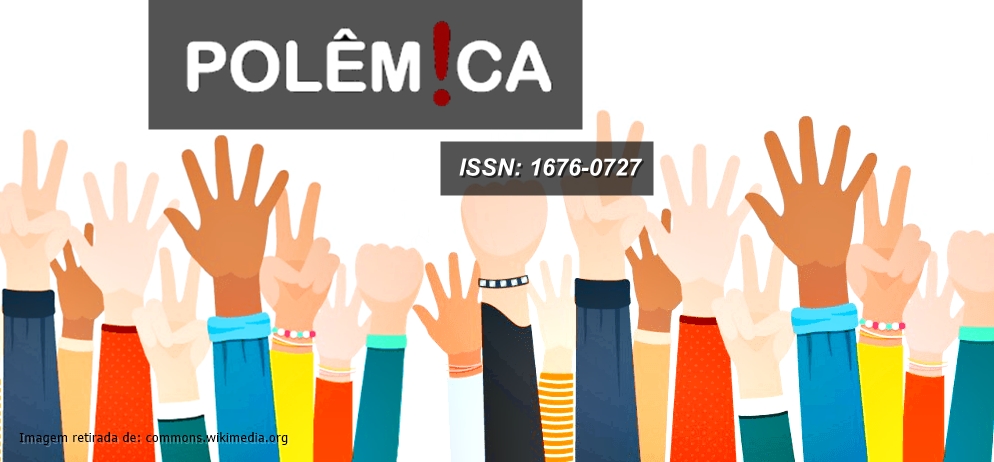INFORMAÇÃO PARA E PELOS SURDOS: SOBRE TRANSMISSÃO AUDIOVISUAL EM LIBRAS E DESENVOLVIMENTO DA CRITICIDADE
DOI:
https://doi.org/10.12957/polemica.2019.47377Abstract
Resumo: Cerca de 5% da população brasileira possui algum grau de perda de audição (IBGE, 2010). São dez milhões de brasileiros com dificuldades de acesso às informações sobre as realidades de seu país e do mundo, ao conhecimento sistematizado pelas ciências etc. Alguns programas audiovisuais recorrem a legendas em Português e/ou intérpretes da Língua Brasileira de Sinais – Libras, atuando nas chamadas “janelinhas”, sendo exceção os produzidos por profissionais surdos e apresentados por eles em primeiro plano na tela. Sob tal contexto de discussão, e partindo da premissa da formação humana ao longo da vida, este artigo apresenta uma problematização acerca das diferenças entre a transmissão de informações por surdos e por intérpretes a partir de pesquisa bibliográfica. O trabalho sugere que uma informação transmitida de surdo para surdo, em audiovisuais, estaria mais próxima ao conteúdo original da mensagem e ao universo linguístico e cultural das comunidades Surdas. Também expõe uma reflexão sobre a necessidade de ampliação do repertório informacional para o desenvolvimento (permanente) da consciência crítica (FREIRE, 1979) pelos surdos que anseiam “ser mais”.
Palavras-chave: Surdez. Libras. Acesso à informação.
Abstract: About 5% of the Brazilian population has some degree of hearing loss (IBGE, 2010). There are ten million Brazilians who have difficulty accessing information about the realities of their country and of the world, knowledge drawn up by the sciences, etc. Some audiovisual programs use Portuguese subtitles and/or Brazilian Sign Language interpreters (Libras) acting in their little "windows" as they are called, with the exception of those produced by deaf professionals and presented to them in the foreground of the screen. Under this context of discussion, and based on the premise of human lifelong training, this article presents an examination of the differences between the transmission of information by deaf people and by interpreters, based on bibliographic research. The paper points out that information transmitted from deaf to deaf in audiovisuals would be closer to the original content of the message, and to the linguistic and cultural universe of the deaf community. It also presents a reflection on the need to expand the informational repertoire for the (permanent) development of critical consciousness (FREIRE, 1979) by deaf people who yearn to "be more."
Keywords: Deafness. Libras. Access to information.
Downloads
Published
How to Cite
Issue
Section
License
Cabem ao autor/autora os direitos autorais dos artigos publicados na Polêm!ca, resguardando-se à revista o direito de primeira publicação. Cientes, revista e autores/as, que todos os artigos são de uso gratuito, para fins educacionais e não-comerciais, permitindo que outros remixem, adaptem e construam sobre o trabalho, desde que citada a fonte, quando da sua utilização integral ou parcial, de acordo com a licença Creative Commons CC BY-NC.
O(s) autor(es) tem/têm autorização para assumir contratos adicionais separadamente, para distribuição não-exclusiva da versão do trabalho publicada nesta revista (ex.: publicar em repositório institucional ou como capítulo de livro), com reconhecimento de autoria e publicação inicial nesta revista.
Respeitando a licença autoral adotada pela Polêm!ca, estimulamos nossos leitores a promover, refletir e escrever, a partir das nossas publicações, incluindo nas citações o link para o artigo disponível no site da Revista Polêm!ca, sempre que um artigo for citado ou replicado, e observando a grafia correta do nome da revista Polêm!ca.
Todo o conteúdo de terceiros (imagens, trechos, citações, etc.) deverá possuir referências a sua fonte original adicionadas como notas de rodapé ou referências bibliográficas com sua devida identificação.
Artigos submetidos que contiverem citações, tabelas ou imagens extraídas de outras publicações não serão aceitos, caso possuam mais conteúdo de terceiros do que conteúdo original.

Revista Polêm!ca está licenciada com uma Licença Creative Commons Atribuição-NãoComercial 4.0 Internacional.



